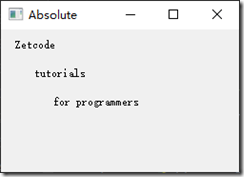【第三节】PyQt5布局管理
PyQt5布局有两种方式,绝对定位和布局类
绝对定位
程序指定每个控件的位置和大小(以像素为单位)。
绝对定位有以下限制:
- 如果我们调整窗口,控件的大小和位置不会改变
- 在各种平台上应用程序看起来会不一样
- 如果改变字体,我们的应用程序的布局就会改变
- 如果我们决定改变我们的布局,我们必须完全重做我们的布局
下面的例子显示了一个绝对定位
#!/usr/bin/python3
# -*- coding: utf-8 -*-
"""
Py40 PyQt5 tutorial
This example shows three labels on a window
using absolute positioning.
author: Jan Bodnar
website: py40.com
last edited: January 2015
"""
import sys
from PyQt5.QtWidgets import QWidget, QLabel, QApplication
class Example(QWidget):
def __init__(self):
super().__init__()
self.initUI()
def initUI(self):
lbl1 = QLabel('Zetcode', self)
lbl1.move(15, 10)
lbl2 = QLabel('tutorials', self)
lbl2.move(35, 40)
lbl3 = QLabel('for programmers', self)
lbl3.move(55, 70)
self.setGeometry(300, 300, 250, 150)
self.setWindowTitle('Absolute')
self.show()
if __name__ == '__main__':
app = QApplication(sys.argv)
ex = Example()
sys.exit(app.exec_())
我们使用move()方法来控制控件的位置
框布局 Boxlayout
我们使用QHBoxLayout和QVBoxLayout,来分别创建横向布局和纵向布局。
#!/usr/bin/python3
# -*- coding: utf-8 -*-
"""
Py40 PyQt5 tutorial
In this example, we position two push
buttons in the bottom-right corner
of the window.
author: Jan Bodnar
website: py40.com
last edited: January 2015
"""
import sys
from PyQt5.QtWidgets import (QWidget, QPushButton,
QHBoxLayout, QVBoxLayout, QApplication)
class Example(QWidget):
def __init__(self):
super().__init__()
self.initUI()
def initUI(self):
okButton = QPushButton("OK")
cancelButton = QPushButton("Cancel")
hbox = QHBoxLayout()
hbox.addStretch(1)
hbox.addWidget(okButton)
hbox.addWidget(cancelButton)
vbox = QVBoxLayout()
vbox.addStretch(1)
vbox.addLayout(hbox)
self.setLayout(vbox)
self.setGeometry(300, 300, 300, 150)
self.setWindowTitle('Buttons')
self.show()
if __name__ == '__main__':
app = QApplication(sys.argv)
ex = Example()
sys.exit(app.exec_())
在这个例子中,我们使用HBoxLayout和QVBoxLayout并添加伸展因子,在窗口的右下角显示两个按钮。
hbox = QHBoxLayout() hbox.addStretch(1) hbox.addWidget(okButton) hbox.addWidget(cancelButton)
我们创建一个水平布局和添加一个伸展因子和两个按钮。两个按钮前的伸展增加了一个可伸缩的空间。这将推动他们靠右显示。
vbox = QVBoxLayout() vbox.addStretch(1) vbox.addLayout(hbox)
创建一个垂直布局,并添加伸展因子,让水平布局显示在窗口底部
self.setLayout(vbox)
最后,我们设置窗口的布局界面

表格布局 QGridLayout
表格布局将空间划分为行和列。我们使用QGridLayout类创建一个网格布局。
#!/usr/bin/python3
# -*- coding: utf-8 -*-
"""
Py40 PyQt5 tutorial
In this example, we create a skeleton
of a calculator using a QGridLayout.
author: Jan Bodnar
website: py40.com
last edited: January 2015
"""
import sys
from PyQt5.QtWidgets import (QWidget, QGridLayout,
QPushButton, QApplication)
class Example(QWidget):
def __init__(self):
super().__init__()
self.initUI()
def initUI(self):
grid = QGridLayout()
self.setLayout(grid)
names = ['Cls', 'Bck', '', 'Close',
'7', '8', '9', '/',
'4', '5', '6', '*',
'1', '2', '3', '-',
'0', '.', '=', '+']
positions = [(i,j) for i in range(5) for j in range(4)]
for position, name in zip(positions, names):
if name == '':
continue
button = QPushButton(name)
grid.addWidget(button, *position)
self.move(300, 150)
self.setWindowTitle('Calculator')
self.show()
if __name__ == '__main__':
app = QApplication(sys.argv)
ex = Example()
sys.exit(app.exec_())
在我们的示例中,我们创建一个网格的按钮。
grid = QGridLayout() self.setLayout(grid)
QGridLayout的实例被创建并设置应用程序窗口的布局。
names = ['Cls', 'Bck', '', 'Close',
'7', '8', '9', '/',
'4', '5', '6', '*',
'1', '2', '3', '-',
'0', '.', '=', '+']
这些按钮的标签。
positions = [(i,j) for i in range(5) for j in range(4)]
我们创建一个网格中的位置的列表。
for position, name in zip(positions, names):
if name == '':
continue
button = QPushButton(name)
grid.addWidget(button, *position)
创建按钮并使用addWidget()方法添加到布局中

评论的例子
控件可以在网格中跨越多个行或列。在下一个示例中,我们说明了这一点。
#!/usr/bin/python3
# -*- coding: utf-8 -*-
"""
Py40 PyQt5 tutorial
In this example, we create a bit
more complicated window layout using
the QGridLayout manager.
author: Jan Bodnar
website: py40.com
last edited: January 2015
"""
import sys
from PyQt5.QtWidgets import (QWidget, QLabel, QLineEdit,
QTextEdit, QGridLayout, QApplication)
class Example(QWidget):
def __init__(self):
super().__init__()
self.initUI()
def initUI(self):
title = QLabel('Title')
author = QLabel('Author')
review = QLabel('Review')
titleEdit = QLineEdit()
authorEdit = QLineEdit()
reviewEdit = QTextEdit()
grid = QGridLayout()
grid.setSpacing(10)
grid.addWidget(title, 1, 0)
grid.addWidget(titleEdit, 1, 1)
grid.addWidget(author, 2, 0)
grid.addWidget(authorEdit, 2, 1)
grid.addWidget(review, 3, 0)
grid.addWidget(reviewEdit, 3, 1, 5, 1)
self.setLayout(grid)
self.setGeometry(300, 300, 350, 300)
self.setWindowTitle('Review')
self.show()
if __name__ == '__main__':
app = QApplication(sys.argv)
ex = Example()
sys.exit(app.exec_())
我们创建一个窗口,其中有三个标签,两个行编辑和一个文本编辑窗口小控件。然后使用QGridLayout完成布局。
grid = QGridLayout() grid.setSpacing(10)
创建一个网格布局和设置组件之间的间距
grid.addWidget(reviewEdit, 3, 1, 5, 1)
在添加一个小的控件到网格的时候,我们可以提供小部件的行和列跨。在例子中,reviewEdit控件跨度5行。(行,列,占用行数,占用列数,对齐方式)

天道酬勤 循序渐进 技压群雄


